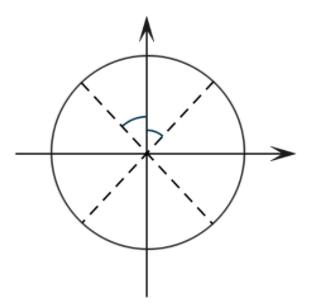
An electric dipole with dipole moment

a) the magnitude of the total electric field at any two points of the circle will be the same.
b) total electric field at point A is
c) the radius R is
d) total electric field at point B is zero.

Answer
480.6k+ views
3 likes
Hint: In the above question, we were told that the radius of the circle is very large than the dipole size. Therefore, we can confirm the circle is equipotential. Next, the net electric field should always be perpendicular to the surface. The electric field at point B along the tangent must be equal to zero.
Complete answer:
Let us write down the given terms and quantities,
The electric field at point b along the tangent will be equal to zero as the circle is confirmed as equipotential.
Therefore,
It is clear that option c is correct.
The electric field
Hence, the total electric field will be different at different points. Option a is incorrect.
The electric field at point A ell be,
Hence, option b is incorrect.
As discussed earlier, the electric field at point B is zero as the circle is equipotential.
Hence, the correct options are option c and d.
Additional information:
An electric dipole is a pair of equal and opposite point charges -q and q, separated by a distance 2a. The direction from q to -q is said to be the direction of the dipole. The electric dipole moment is a measure of the separation of the positive and negative electric charge within a system, that is, a measure of the system's overall polarity. SI units of the dipole moment are coulomb meter. In atomic physics and chemistry, we use a common unit called Debye.
Note:
The angle involved in the electric dipole is defined with respect to the electric field lines. Most of us assume that the angler involved in the electric dipole is defined with respect to equipotential lines. Dimensional analysis also should be taken care of during the calculations.
Complete answer:
Let us write down the given terms and quantities,
The electric field at point b along the tangent will be equal to zero as the circle is confirmed as equipotential.
Therefore,
It is clear that option c is correct.
The electric field
Hence, the total electric field will be different at different points. Option a is incorrect.
The electric field at point A ell be,
Hence, option b is incorrect.
As discussed earlier, the electric field at point B is zero as the circle is equipotential.
Hence, the correct options are option c and d.
Additional information:
An electric dipole is a pair of equal and opposite point charges -q and q, separated by a distance 2a. The direction from q to -q is said to be the direction of the dipole. The electric dipole moment is a measure of the separation of the positive and negative electric charge within a system, that is, a measure of the system's overall polarity. SI units of the dipole moment are coulomb meter. In atomic physics and chemistry, we use a common unit called Debye.
Note:
The angle involved in the electric dipole is defined with respect to the electric field lines. Most of us assume that the angler involved in the electric dipole is defined with respect to equipotential lines. Dimensional analysis also should be taken care of during the calculations.
Recently Updated Pages
Master Class 12 Business Studies: Engaging Questions & Answers for Success

Master Class 12 English: Engaging Questions & Answers for Success

Master Class 12 Social Science: Engaging Questions & Answers for Success

Master Class 12 Chemistry: Engaging Questions & Answers for Success

Class 12 Question and Answer - Your Ultimate Solutions Guide

Master Class 11 Economics: Engaging Questions & Answers for Success

Trending doubts
Draw a labelled sketch of the human eye class 12 physics CBSE

a Tabulate the differences in the characteristics of class 12 chemistry CBSE

Which one of the following is a true fish A Jellyfish class 12 biology CBSE

Why is the cell called the structural and functional class 12 biology CBSE

Differentiate between homogeneous and heterogeneous class 12 chemistry CBSE

Write the difference between solid liquid and gas class 12 chemistry CBSE




